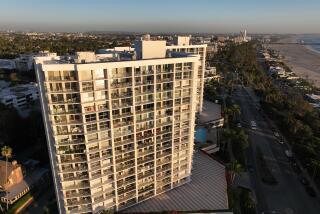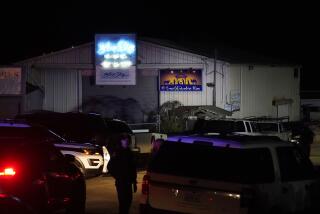A hot air balloon fight in the Coachella Valley
Reporting from Indio -- Nearly every winter sunrise for decades, hot air balloons floated above the Coachella Valley. People on the ground would wave and admire the chromatic airships, while the passengers would gaze down at the date palm groves, the sere desert floor, the plum shadows on the San Jacintos.
Then the Marrellis came to town.
They bought an 80-acre parcel in 1999, double-fenced it and planted it with thousands of olive trees. When the trees were grown and provided a screen, they started building a compound in the style of a “Moorish fortress castle”: two sprawling buildings and a bell tower, surrounded by 24-foot-high walls — four feet thick — with turrets on each corner and a deep moat at the entrance.
In a business plan marked “personal and confidential” contained in a court file, they called it Oasis Ranch and stressed the need for privacy, exclusivity and security at what they described as a “getaway” and a “retreat.”
Neighbors never met John and Carol Marrelli — who lived on a hillside estate in Del Mar, according to voter registration records — and knew little of the castle; the trees hid all but the barrel-tiled roof of the tower.
Only later would they learn how much the family disliked having hot air balloons fly overhead.
Cindy Wilkinson, who owns Fantasy Balloon Flights with her husband, got her first cease-and-desist letter on Nov. 20, 2007.
Attorneys for the Marrellis alleged that her balloons were flying too low over Oasis Ranch, violating Federal Aviation Administration rules and creating a “public nuisance” and an “invasion of privacy” amounting to “harassment.”
“If that was not enough, we received a phone call from our construction superintendent (the ranch is under construction) who indicated that a worker nearly plunged to his death from the 55’ tower … when he was startled by one of your balloons flying dangerously close to the property,” according to the letter.
The attorney asked that the balloons stop floating over the property at all — even though they had a right to fly at 500 feet or less while taking off or landing — or face “immediate legal action.”
Oasis Ranch sits in the middle of the La Quinta cove, a flat area of calm winds between two rocky spines of the San Jacintos. It is the prime ballooning area of the valley, with plenty of empty spots to take off and land, and polo grounds that host annual balloon festivals.
“It’s pretty much the worst spot to be if you don’t like balloons,” said pilot John Hennigan, who has flown the area since 1991.
Wilkinson said she had never received such a complaint in 26 years of offering balloon rides in the Coachella Valley.
She wrote back to the Marrellis’ attorney, disputing the interpretation of FAA rules but agreeing to cooperate.
“Hot air balloons have been flying in the area for the past 40 years,” she wrote. “Now that you have brought to my attention that you do not like the balloons so strongly … we will try to avoid the property, and will instruct other balloonists to avoid the area also.”
It seemed like no big deal to her. The property was just one among hundreds in a vast green and brown checkerboard of farms and scattered homes.
The Wilkinsons received repeat letters in March 2008. By then, several other balloonists had received similar notices, including the company Hennigan worked for.
Then came the lawsuit. Filed March 27, 2009, against four operators, it would ultimately target every balloon company and pilot in the valley, alleging that they were still flying low over the property and making loud noises. It sought a permanent injunction against any overflights, as well as unspecified damages and attorney fees.
The Marrellis also filed complaints with the FAA, which investigated and found no violations.
Most of the balloonists were already suffering from the recession. Hennigan had just started his own company. “I could barely afford the propane, much less lawyers,” he said. After the lawsuit, he sold his equipment and took a pilot’s job in Temecula.
Denni Barrett and his wife, Shiho Seki, refused to abandon one of the three major hot air balloon markets in Southern California (along with Del Mar and Temecula). He hired an attorney to deal with all the motions, objections, hearings and depositions.
Cindy and Steve Wilkinson fought the suit on their own.
“Every day it seemed like something was coming over the fax that I had to deal with,” Cindy said. “I was in depositions for 41/2 days. And I have never even flown over the property.”
The Marellis’ companies, JCM Farming Inc. and Equity Ag Financial, added more balloonists to the lawsuit, as well as two real estate firms that advertised on the balloons. The Wilkinsons said they couldn’t get pilots to fly for them.
“Nobody can afford to fight these people,” Cindy Wilkinson said. “They know if they come out and fly, they could lose everything.”
Barrett, who was spending tens of thousands of dollars on legal fees, started working only in Temecula and Del Mar. The Castellions decamped to Colorado. The Castaniers went out of business.
By winter 2010, the Wilkinsons were the only ones left flying, and their business was down 80%.
::
On Jan. 31, the Desert Sun published an extensive story headlined, “Mysterious east valley farm’s lawsuits ground nearly all local hot air balloons.” It mentioned that by then the Marrellis had sued a crop-duster, the U.S. Department of Agriculture and the FAA over alleged low flights — at the same time they were trying to get their own permit for a helipad.
Follow-up reports revealed they had sued three of the contractors who built Oasis Ranch and also filed suit against a neighbor over a barking dog.
Reaction was searing. “Go away, you don’t belong here you sue happy low lifes,” read one of hundreds of resoundingly unfavorable comments on the Desert Sun website.
“Everyone, to a person, I have spoken to is upset that one landowner could shut down viable business enterprises because they don’t like it,” said Riverside County Supervisor John Benoit.
Speculation as to what was going on behind those walls ran rampant. The Marrellis’ business plan called the ranch a “Private Event and Meeting Center” — “a respite for and marketed to State Departments, foreign dignitaries, diplomats, Fortune 500 executives and their boards, ultra high net worth individuals and their families and celebrities.”
The couple, who ran the company with their daughter Marilena, hired a public relations professional, Nancy Conrad, to deal with the fallout. She told the Desert Sun they received death threats after the article and found a “fresh bullet” at the compound.
The family wrote a letter to the newspaper making their case that their “olive farm” had “become a featured tourist attraction from the air.”
“On any given day, over the past few years, we have been awakened as early as 6:30 a.m. to the sound of balloon burners as they drop down as low as window level of our top floor. With it comes a basket of people shouting hello and snapping pictures of us. We might be in our pajamas or trying to enjoy a cup of coffee on the patio, and suddenly there are people gawking at us and trying to converse as if they were just passers-by.”
Barrett calls this “ridiculous,” noting that balloons are mostly subject to where the wind takes them.
A few days after the initial article, a local attorney, Robert Gilliland Jr., took on the balloonists’ case pro bono. Over the next few months, the Marrellis’ attorney, Andrew Rauch, tried to get court records sealed and a gag order imposed on everyone involved. He argued that a “vilification campaign” threatened the family’s safety. The motions were denied.
Gilliland sought to inspect the ranch, based on Rauch’s claim that the business suffered $750,000 in damages. Rauch argued that an inspection would violate his clients’ privacy and filed a declaration from a designer calling the project’s architecture “an original artistic presentation” containing “trade secrets.” The judge again ruled in favor of the balloonists.
The legal maneuvering continued, but Gilliland figured they would never agree to the inspection, scheduled for today.
By Monday afternoon, the Marrellis apparently had had enough.
They did not answer emailed questions but issued a statement describing themselves as a farming and real estate development company that had “always valued our privacy.”
Even though they believed their case was important, they said, “vicious hate-speech mongers” and “irrational Internet bloggers” had made a fair trial impossible.
The statement admonished the press for all the “‘what are they hiding?’ baseless questions about what … ‘rich arrogant people’ are doing cloak-and-dagger behind those thick walls in that ‘turret’ framed ‘mysterious,’ ‘secretive compound.’ ”
That same afternoon, Gilliland received the paperwork in the mail: The Marrellis were dropping the case.
“On one hand I’m elated,” he said. “On the other hand, I’m waiting to see what they do next.”
More to Read
Start your day right
Sign up for Essential California for news, features and recommendations from the L.A. Times and beyond in your inbox six days a week.
You may occasionally receive promotional content from the Los Angeles Times.







